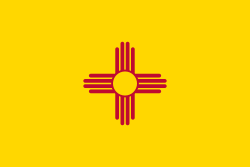
The following outline is provided as an overview of and topical guide to the U.S. state of New Mexico:
Contents
- General reference
- Geography of New Mexico
- Places in New Mexico
- Environment of New Mexico
- Regions of New Mexico
- Demography of New Mexico
- Government and politics of New Mexico
- Branches of the government of New Mexico
- Law and order in New Mexico
- Military in New Mexico
- History of New Mexico
- History of New Mexico, by period
- History of New Mexico, by region
- History of New Mexico, by subject
- Culture of New Mexico
- The Arts in New Mexico
- Sports in New Mexico
- Economy and infrastructure of New Mexico
- Education in New Mexico
- See also
- References
- External links
New Mexico – U.S. state located in the southwest region of the United States. It is the state with the highest percentage of Hispanics, including descendants of Spanish colonists and recent immigrants from Latin America. Congress admitted New Mexico to the Union as the 47th State on January 6, 1912.



